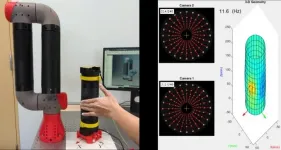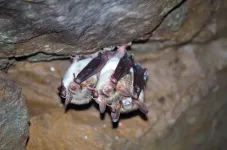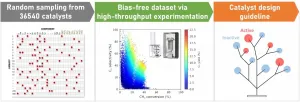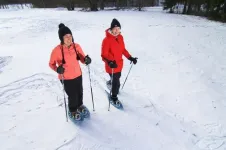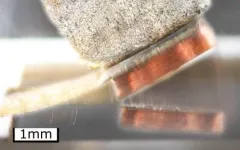(Press-News.org) Modern-day robots are often required to interact with humans intelligently and efficiently, which can be enabled by providing them the ability to perceive touch. However, previous attempts at mimicking human skin have involved bulky and complex electronics, wiring, and a risk of damage. In a recent study, researchers from Japan sidestep these difficulties by constructing a 3D vision-guided artificial skin that enables tactile sensing with high performance, opening doors to innumerable applications in medicine, healthcare, and industry.
Robots have come a long way since their original inception for high-speed automation. Today, robots can be found in a wide variety of roles in medicine, rehabilitation, agriculture, and marine navigation. Since a lot of these roles require human contact, robots are expected to become adept at interacting with humans in a safe and intelligent manner.
One way to accomplish this goal is by endowing robots with the ability to perceive touch. Accordingly, attempts have been made to develop artificial "skins" capable of inducing tactile sensations and allowing robots to be more aware of their surrounding environment, in the same way humans are. However, despite great advances in tactile sensor technology, the endeavor remains challenging. "The main challenge lies in mimicking the inherent complexity of natural skin structure that has a particularly high density of mechanoreceptors with specialized functions such as sensing pressure, vibrations, temperature, and pain," says Associate Professor Van Anh Ho from Japan Advanced Institute of Science and Technology, where he leads a laboratory working on soft haptic technology. He adds, "All approaches so far have only focused on developing a skin-like structure with a matrix of different sensors without considering the bulk of wires, electronic components, and the risk of damage from frequent contact."
In a new study published in IEEE Transactions on Robotics, Prof. Ho and his colleague Lac Van Duong, a doctoral student at JAIST, developed a high-performance, vision-based artificial sensing system that is low-cost, has a relative simple structure, and is scalable. Named TacLINK, this system can process tactile information and even determine contact force and contact geometry upon interacting with the surroundings.
The researchers based the structure of TacLINK essentially on a transparent acrylic tube (serving as a rigid bone frame) covered by a continuous soft artificial skin with a sensing area of about 500 cm2. They used silicone rubber to fabricate the artificial skin due to its high elasticity and smoothness. Moreover, the material could be inflated to change its form and stiffness. The researchers printed an array of markers on the surface of this skin to track its deformation instead of embedding sensors or electronic components inside the skin. This greatly reduced its bulkiness, cost, and chances of possible damage.
The vision system consisted of two co-axial cameras arranged to form a stereo camera that tracked the 3D displacement of the markers on the inner wall of the skin. In addition, researchers employed a finite element model (FEM) to estimate the structural stiffness of the skin. By combining the data from both these sources, they were able to reconstruct the contact geometry and contact force distribution simultaneously. Moreover, unlike in previous studies, this method worked for multiple contact points.
With such positive outcomes, Prof. Ho is hopeful about the creation of a future generation of touch-sensing-enabled robotic devices. "The artificial skin used in our study can be easily fabricated by the casting method and can, therefore, be implemented on other parts of robots, such as fingers, legs, chests, and heads, and even for smart prosthetics for humans, allowing a disabled person to perceive sensations the same way as a normal human," comments Prof. Ho excitedly. "In addition, it can also be used to design various sensory devices in medicine, healthcare, and industry. In fact, it is especially suited for the development of robotic systems in the post-COVID era to enable remote service with robotic avatars."
It certainly seems like the robots of the near future will be "touching" human lives more than ever before!
INFORMATION:
About Japan Advanced Institute of Science and Technology, Japan
Founded in 1990 in Ishikawa prefecture, the Japan Advanced Institute of Science and Technology (JAIST) was the first independent national graduate school in Japan. Now, after 30 years of steady progress, JAIST has become one of Japan's top-ranking universities. JAIST counts with multiple satellite campuses and strives to foster capable leaders with a state-of-the-art education system where diversity is key; about 40% of its alumni are international students. The university has a unique style of graduate education based on a carefully designed coursework-oriented curriculum to ensure that its students have a solid foundation on which to carry out cutting-edge research. JAIST also works closely both with local and overseas communities by promoting industry-academia collaborative research.
About Professor Van Anh Ho from Japan Advanced Institute of Science and Technology, Japan
Van Anh Ho is an associate professor at International Research Center for Innovation Design at the Japan Advanced Institute of Science and Technology (JAIST). He received his Ph.D. degree in robotics from Ritsumeikan University, Kyoto, Japan, in 2012. From 2015 to 2017, he worked as Assistant Professor with Ryukoku University, where he led a laboratory on soft haptics. From 2017, he joined JAIST for setting up a laboratory on soft robotics. His current research interests are soft robotics, soft haptic interaction, tactile sensing, grasping and manipulation, bio-inspired robots.
Modern immunotherapeutic anti-cancer drugs support a natural mechanism of the immune system to inhibit the growth of cancer cells. They dock onto a specific receptor of the killer cell and prevent it from being switched off by the cancer cells. This is a complex molecular process, which is known but has not yet been fully understood. In a molecular dynamics study conducted by the group led by medical information scientist Wolfgang Schreiner and gynaecologists Heinz Kölbl and Georg Pfeiler from MedUni Vienna, working with biosimulation expert Chris Oostenbrink ...
What are the reasons for such a contrast in outcomes? A scientist team led by the Leibniz Institute for Zoo and Wildlife Research (Leibniz-IZW) has now analysed the humoral innate immune defence of European greater mouse-eared bats to the fungus. In contrast to North American bats, European bats have sufficient baseline levels of key immune parameters and thus tolerate a certain level of infection throughout hibernation. The results are published in the journal "Developmental and Comparative Immunology".
During infections caused by Pseudogymnoascus destructans (Pd), North American bats arouse frequently from ...
To date, research in the field of combinatorial catalysts has relied on serendipitous discoveries of catalyst combinations. Now, scientists from Japan have streamlined a protocol that combines random sampling, high-throughput experimentation, and data science to identify synergistic combinations of catalysts. With this breakthrough, the researchers hope to remove the limits placed on research by relying on chance discoveries and have their new protocol used more often in catalyst informatics.
Catalysts, or their combinations, are compounds that significantly lower the energy required to drive chemical reactions to completion. In the field of "combinatorial catalyst design," the requirement of synergy--where one component ...
Life changes influence the amount of physical activity in a person, according to a recent study by the University of Jyväskylä. The birth of children and a change of residence, marital status and place of work all influence the number of steps of men and women in different ways. For women, having children, getting a job and moving from town to the countryside reduce everyday exercise.
A study conducted by the Faculty of Sports & Health Sciences found that the birth of the first child significantly reduces the number of everyday steps in women. As children grow, women's aerobic steps, in turn, increase. Although the birth of children did not have a statistically significant effect on the number of steps in men, changes were also observed ...
Use of waste heat contributes largely to sustainable energy supply. Scientists of Karlsruhe Institute of Technology (KIT) and T?hoku University in Japan have now come much closer to their goal of converting waste heat into electrical power at small temperature differences. As reported in Joule, electrical power per footprint of thermomagnetic generators based on Heusler alloy films has been increased by a factor of 3.4. (DOI: 10.1016/j.joule.2020.10.019)
Many technical processes only use part of the energy consumed. The remaining fraction leaves the system ...
In the race to stop the spread of COVID-19, a three-layer cloth mask that fits well can effectively filter COVID particles, says a group of UBC researchers.
After testing several different mask styles and 41 types of fabrics, they found that a mask consisting of two layers of low-thread-count quilting cotton plus a three-ply dried baby wipe filter was as effective as a commercial non-surgical mask at stopping particles--and almost as breathable.
The cloth masks filtered out up to 80 per cent of 3-micron particles, and more than 90 per cent of 10-micron particles.
"We focused on particles larger than one micron because these are likely most important to COVID-19 transmission," explains researcher Dr. Steven Rogak, a professor of mechanical engineering who ...
The genus Ficus (figs) and their agaonid pollinating fig wasps are a classic example of coevolution. It represents perhaps the most extreme and ancient (about 75 million years) obligate pollination mutualism known.
Previous studies have suggested that pollinator host-switching and hybridization existed in some fig taxa with genetic evidence based on relatively few genes. However, those cases were mainly treated as rare exceptions, and strict-sense coevolution was still treated as the dominate coevolution model for the codiversification of this "extreme" obligate pollination system with high species richness.
Together with colleagues from 11 institutions from home and abroad, researchers from the Xishuangbanna Tropical Botanical ...
Scientists at Scripps Research have clarified the workings of a mysterious protein called Gαo, which is one of the most abundant proteins in the brain and, when mutated, causes severe movement disorders.
The findings, which appear in Cell Reports, are an advance in the basic understanding of how the brain controls muscles and could lead to treatments for children born with Gαo-mutation movement disorders. Such conditions--known as GNAO1-related neurodevelopmental disorders--were discovered only in the past decade, and are thought to affect at least hundreds of children around the world. Children with the disease suffer from severe developmental ...
World-first 3D printed oesophageal stents developed by the University of South Australia could revolutionise the delivery of chemotherapy drugs to provide more accurate, effective and personalised treatment for patients with oesophageal cancer.
Fabricated from polyurethane filament and incorporating the chemotherapy drug 5-fluorouracil (5-FU), the new oesophageal stents are the first to contain active pharmaceutical ingredients within their matrix .
Their unique composition allows them to deliver up to 110 days of a sustained anti-cancer medication directly to the cancer site, restricting further tumour growth.
Importantly, the capabilities of 3D printing enabling rapid creation of individually tailored stents with patient-specific geometries and drug dosages.
PhD ...
The COVID-19 pandemic is a great example of the importance of access to the Internet and to digital health information. Unfortunately, historical disparities in health care appear to be reflected in computer ownership, access to the Internet and use of digital health information. However, few studies have qualitatively explored reasons for digital health information disparity, especially in older adults.
A study led by Florida Atlantic University's Christine E. Lynn College of Nursing in collaboration with the Dana-Farber Cancer Institute and the University of Massachusetts Medical ...
